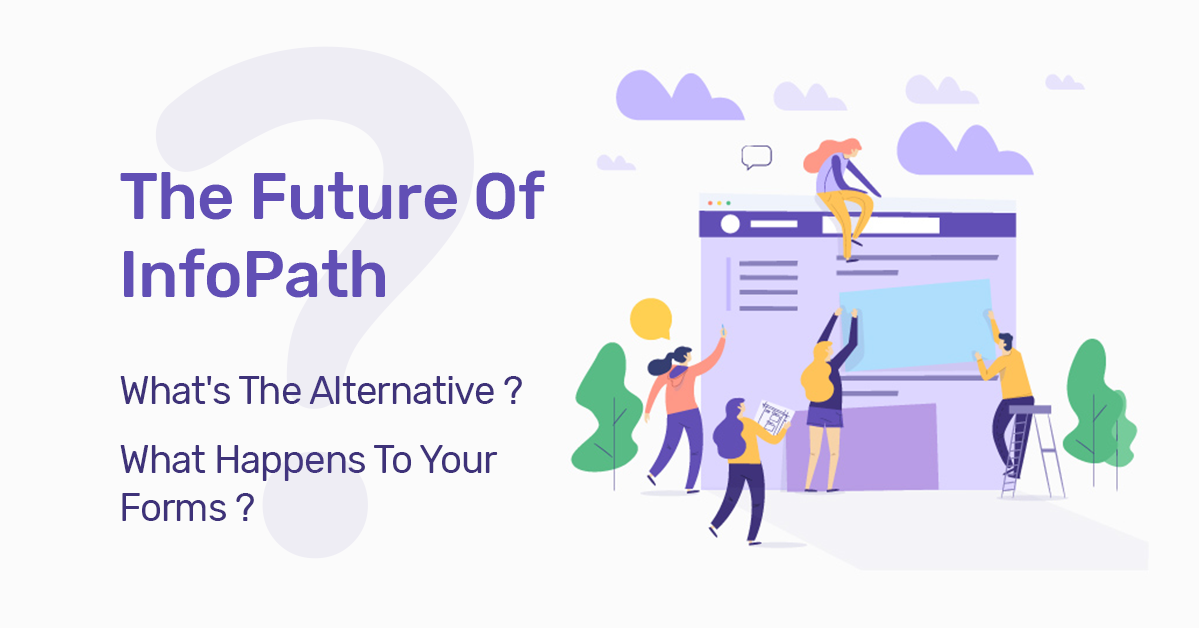The Future Of InfoPath & SharePoint Forms

What’s The Future Of InfoPath?
Yes, Microsoft has decided to discontinue InfoPath which worked mostly on top of SharePoint and replaced it with a more cross-platform-ish alternative called PowerApps. However, Microsoft will keep supporting InfoPath till 2026, but there won’t be any updates to the core product such as feature additions. In this article, we are discussing the future and transitioning of Infopath into PowerApps and what is on hold for its users.
What Is InfoPath Used For?
In SharePoint hosted environments, InfoPath is used as a form creation and data capturing tool which was capable of gathering data from multiple sources like XML, web services and databases.
For companies or institutions, it was an easy way to gather structured data from many sources. The basic premise of Microsoft launching this in 2000 was to enable users to create a variety of forms without actually coding it.
The form creators were provided with options to create business logic, rules and also validate the content in the forms. Without getting into too much detail, the whole process of creating the forms in InfoPath could be summarized into a few steps which are planning, adding templates and layout, adding data connections, business logic, adding access controls and then publishing it.
What Will Replace InfoPath forms?
InfoPath is slowly transitioning into PowerApps, which is envisaged as a tool that helps create custom business apps on top of the existing Microsoft services like SharePoint, Azure, Office 365 and a lot more. It says in the PowerApps website, “We make it easy to get your data into your apps with more than 200 connectors for many popular cloud services and even your on-premises data”. With many templates and interfaces with a drag and drop approach, designers and/or developers could easily create screens or forms that can perform CRUD operations.
When InfoPath had specific use cases among its users, what makes the PowerApps an obvious improvement is that it lets you create an entire business application in a very limited amount of time. One area in which Microsoft had a specific focus on is where it took the customization capabilities of Dynamics and brought it within PowerApps. What you need to understand is that whether it is InfoPath or PowerApps, both are meant to be used for internal use. There were built for a replacement for things, for instance, an internal onboarding application, task management, etc. Businesses internally can install a native PowerApp in their phone or PC and launch an internal application from it. Even though it has some business logic, it is not actually meant for much larger applications with lots of logic which typically .Net would support.
Can PowerApps Replace InfoPath?
Along with all the benefits, there are also some disadvantages too. As far as the app performance is concerned, native apps are much faster as compared to this one. Some developers have even reported a difference in 3-5 seconds in app load time. If you need to run multiple apps at the same time, then PowerApps might not be the right fit for you, especially in mobile environments. However, on the web, you can run multiple apps in the same account. Another important drawback is that being an internally implementable app, the apps cannot be published to the app store or play store. None of these are huge issues and we are sure Microsoft will improve these with the latest updates.
Migrating InfoPath forms to Power apps
Even though InfoPath is considered as a SharePoint first product, originally, it was not built to work with it. Later on, InfoPath was refitted to suit Sharepoint so that the forms could be easily used whereas PowerApps is an Azure first product. PowerApps require a constant internet connection and this is going to be extremely difficult especially for people who may not have an active internet connection like on-field workforce in industries like construction, delivery, etc. It doesn’t even cache the data offline and then sync it later when connectivity is available. Maybe they would introduce this later on, but it is highly unlikely since they have extended support for InfoPath only till 2026. So for now, it seems the only alternative is to continue using InfoPath and this presents a much bigger problem.
Now that these older versions are being replaced to support Microsoft’s cloud-first approach, the organizations using InfoPath will need to start looking at alternatives that would suit their requirement. But it is extremely difficult. Why? Because the underlying technology of both these software does not function the same way and hence you need to rebuild most of these forms which are going to be a big bottleneck for most of the old users who have the InfoPath forms especially in local servers. When people move from on-premise SharePoint to SharePoint hosted in the cloud, existing InfoPath forms will just stop working. This worries many existing users and they are looking for solutions.
Is there a better way to create SharePoint forms without InfoPath?
Knowing that InfoPath is going down the drain in a few years and PowerApps may never have InfoPath like features, it is up to the users to find alternatives. An option that the users can have a look at is ClaySys AppForms.
ClaySys AppForms is a metadata-driven low code development platform that can be used to build forms, workflows, and apps. You can create basic forms for migration from paper forms to electronic forms, to a complex line of business applications using AppForms.
It has all the features of InfoPath and can also be used in a local network. On top of that, the Forms created in AppForms can be connected to varied data sources like SharePoint lists/libraries, SQL Server, Oracle, Web Services, RESTFul Services, SQL Azure, Azure Storage amongst others.
Any functionality created in AppForms is future-proof, as all existing functionality continues to work in future versions of the product.
Get Started with our Appforms Development Services